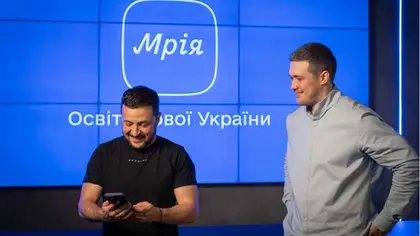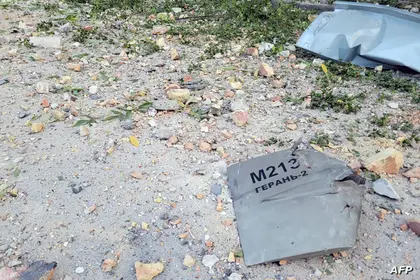Ukraine vowed to become a fully digital country just months ahead of Russia’s full-scale invasion and has continued working towards that goal even as the war intensified. The Ministry of Digital Transformation led the way through its Diia mobile app portal, which now allows more than 21 million Ukrainians to access over 70 government services and to store and access 14 essential digital documents.
The same ministry, headed by Mykhailo Fedorov, has been the driving force behind a whole range of technological innovations. Its work on unmanned aerial, ground and seaborne vehicles – drones – has grabbed the headlines as they are considered to have transformed the way a modern war is fought.
JOIN US ON TELEGRAM
Follow our coverage of the war on the @Kyivpost_official.
Yet the work his ministry and others have done on mobile apps to support military functions, while much less sexy than drones that sink ships, are just as essential for the protection of the country.
Smart phones for smart air defense
One such area is the use of mobile phones and purpose-built apps to support the air defense effort to counter the ongoing onslaught against Ukraine’s cities and infrastructure by Russian missiles and kamikaze drones.
The first example of this was the ePPO, first unveiled in the autumn of 2022. It was a simple phone app that “piggy-backed” on the Diia system to allow ordinary citizens to report sightings of incoming Russian aerial weapons.

Artificial Intelligence Raises Ukrainian Drone Kill Rates to 80%
Work on the app by an enthusiastic and technologically capable group of volunteers began within days of Russia’s full-scale invasion and was unveiled just as the use of the Shahed 136/Geran-2 kamikaze drones ramped up.
The aim is to enlist the entire population in helping to spot incoming attacks as an example of “web-centric war.”
The ePPO app, uses the smartphone’s in-built GPS and compass to pinpoint the user’s location. On hearing or seeing an approaching target it was only necessary to point their cellphone in the direction of the incoming object and press a single button. The app would then send a location report to the country’s military.
The project developers said the aim was to enlist “the entire population” in helping to spot incoming attacks in what he described as an example of “web-centric war.” As more users registered the aerial targets, an accurate track pattern could be compiled to warn Ukraine’s air defense to engage and destroy the target.
The Guardian quoted Samuel Bendett, a drones expert and adviser to the US-based CNA military thinktank, in October 2022, who said he thought the app would be a useful adjunct of Ukraine’s layers of air defense. “Every bit of data can help to pinpoint the origin and trajectory of the attack,” he said.
The idea of volunteer civilian spotters isn’t that new, even if the technology being used is. During World War II the UK relied on the volunteers of the Royal Observer Corps to pinpoint German aircraft approaching the UK. Around 30,000 volunteers worked closely with the Royal Air Force to identify the direction and types of enemy planes as they attacked the country’s cities and defense industry.
Justin Bronk, an aviation analyst with the Royal United Services Institute (RUSI) said that in 2022 Ukraine does not have the equipment to adequately monitor its low-level airspace continuously. He said that “updates from spotters help the air defense network plot the course of missile and loitering munition raids, to alert air defense units along their course and tailor air raid warnings.”
Listening closely
A report in the Daily Telegraph on Tuesday, March 26 detailed how this simple approach had been developed and automated so that spotting became less reliable on an enthusiastic volunteer happening to be in the right place at the right time.
It says that Ukraine has established a network that uses thousands of stand-alone mobile phones to track incoming drones and missiles. The secret scheme was disclosed by General James Hecker, head of US Air Forces in Europe, during a recent meeting.
Without giving the details of the project, he revealed that it is based on an app that puts an acoustic sensor on the mobile phone. The data acquired by the phone is then fed into Ukraine’s “Virazh” national air defense command and control network, which combines input from around 40 separate kinds of sensors to detect, identify and track incoming aerial threats.
What makes this different from ePPO is how the detection and identification system has been automated in a formal network, funded through the Safe Skies initiative by President Volodymyr Zelensky’s United24 platform.
In its first, most basic iteration, the system was put together by the “Skyfortress” NGO and was deployed in areas close to the front line. It consists of a detection station which links a normal android smartphone with other commercial electronics housed in a box that is mounted on things such as telegraph poles and electricity pylons, even trees; where nothing suitable is available a six-foot-high pole is used.
The system is constantly switched on to detect and record the sound of incoming aerial targets. It uses artificial intelligence to differentiate detected sounds, such as animals or even cars, from that of drones and missiles. Once it confirms it is an enemy weapon the information is sent back to a centralized repository using a standard local mobile phone network.
Fedorov told The Telegraph: “It’s really helpful for us in order to get a better understanding of what’s going on in our skies. It’s quite a revolutionary breakthrough technology.”
The basic idea is now being expanded both in scope and in the technology being used. The next generation system known as Zvook, will aim to deploy more than 12,000 sensors in the border regions of Ukraine on likely Russian missile approach routes.
Zvook will use micro-computers, rather than cell phones and is thought to be able to detect drones at a distance of 5 kilometers (3 miles), cruise missiles at 6 kilometers (4 miles), and ballistic missiles at 10 kilometers (6 miles).
Maryan Sulym, chief executive officer of Zvook, said: “We detect the air threats and then the military can turn on its radar systems to highlight a particular region… It’s an auxiliary system. It’s not replacing radar but making it more efficient.”
General Hecker said because of the existing detection system, mobile firing groups had been able to engage and intercept more than 80 Shaheds since they were put in place and Ukraine expects the new system to have an even higher degree of success.
Hecker said a number of NATO countries were interested in this or similar systems to supplement their own air defense networks.
The remains of a WWII acoustic aircraft detector on the UK’s Kent Coast
The use of acoustic systems to detect aerial threats was also used by the UK during the Second World War, in the form of giant domed concrete receptors that could pick up and amplify the sound of incoming enemy aircraft. Trained observers could use the detected noise to calculate the height, speed, and direction of incoming enemy planes.
You can also highlight the text and press Ctrl + Enter







